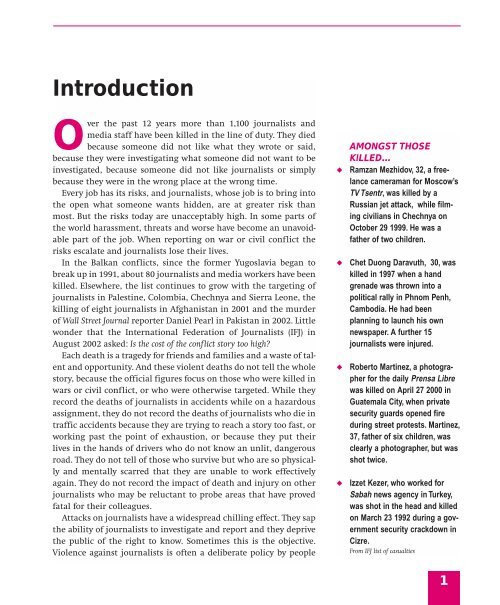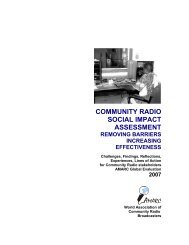Live News - A Survival Guide - International Federation of Journalists
Live News - A Survival Guide - International Federation of Journalists
Live News - A Survival Guide - International Federation of Journalists
- No tags were found...
You also want an ePaper? Increase the reach of your titles
YUMPU automatically turns print PDFs into web optimized ePapers that Google loves.
IntroductionOver the past 12 years more than 1,100 journalists andmedia staff have been killed in the line <strong>of</strong> duty. They diedbecause someone did not like what they wrote or said,because they were investigating what someone did not want to beinvestigated, because someone did not like journalists or simplybecause they were in the wrong place at the wrong time.Every job has its risks, and journalists, whose job is to bring intothe open what someone wants hidden, are at greater risk thanmost. But the risks today are unacceptably high. In some parts <strong>of</strong>the world harassment, threats and worse have become an unavoidablepart <strong>of</strong> the job. When reporting on war or civil conflict therisks escalate and journalists lose their lives.In the Balkan conflicts, since the former Yugoslavia began tobreak up in 1991, about 80 journalists and media workers have beenkilled. Elsewhere, the list continues to grow with the targeting <strong>of</strong>journalists in Palestine, Colombia, Chechnya and Sierra Leone, thekilling <strong>of</strong> eight journalists in Afghanistan in 2001 and the murder<strong>of</strong> Wall Street Journal reporter Daniel Pearl in Pakistan in 2002. Littlewonder that the <strong>International</strong> <strong>Federation</strong> <strong>of</strong> <strong>Journalists</strong> (IFJ) inAugust 2002 asked: Is the cost <strong>of</strong> the conflict story too high?Each death is a tragedy for friends and families and a waste <strong>of</strong> talentand opportunity. And these violent deaths do not tell the wholestory, because the <strong>of</strong>ficial figures focus on those who were killed inwars or civil conflict, or who were otherwise targeted. While theyrecord the deaths <strong>of</strong> journalists in accidents while on a hazardousassignment, they do not record the deaths <strong>of</strong> journalists who die intraffic accidents because they are trying to reach a story too fast, orworking past the point <strong>of</strong> exhaustion, or because they put theirlives in the hands <strong>of</strong> drivers who do not know an unlit, dangerousroad. They do not tell <strong>of</strong> those who survive but who are so physicallyand mentally scarred that they are unable to work effectivelyagain. They do not record the impact <strong>of</strong> death and injury on otherjournalists who may be reluctant to probe areas that have provedfatal for their colleagues.Attacks on journalists have a widespread chilling effect. They sapthe ability <strong>of</strong> journalists to investigate and report and they deprivethe public <strong>of</strong> the right to know. Sometimes this is the objective.Violence against journalists is <strong>of</strong>ten a deliberate policy by people◆◆◆◆AMONGST THOSEKILLED…Ramzan Mezhidov, 32, a freelancecameraman for Moscow’sTV Tsentr, was killed by aRussian jet attack, while filmingcivilians in Chechnya onOctober 29 1999. He was afather <strong>of</strong> two children.Chet Duong Daravuth, 30, waskilled in 1997 when a handgrenade was thrown into apolitical rally in Phnom Penh,Cambodia. He had beenplanning to launch his ownnewspaper. A further 15journalists were injured.Roberto Martinez, a photographerfor the daily Prensa Librewas killed on April 27 2000 inGuatemala City, when privatesecurity guards opened fireduring street protests. Martinez,37, father <strong>of</strong> six children, wasclearly a photographer, but wasshot twice.Izzet Kezer, who worked forSabah news agency in Turkey,was shot in the head and killedon March 23 1992 during a governmentsecurity crackdown inCizre.From IFJ list <strong>of</strong> casualties1
















